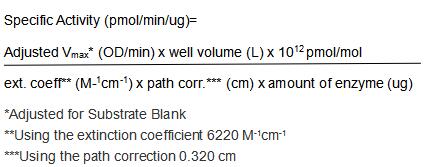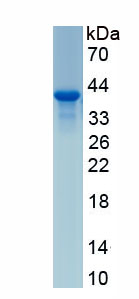Active Lactate Dehydrogenase C (LDHC) 

LDH-C; CT32; LDHX; LDH3; Cancer/Testis Antigen 32; LDH testis subunit
- UOM
- FOB US$ 280.00 US$ 700.00 US$ 1,400.00 US$ 4,200.00 US$ 10,500.00
- Quantity
Overview
Properties
- Product No.APE131Ra01
- Organism SpeciesRattus norvegicus (Rat) Same name, Different species.
- ApplicationsCell culture; Activity Assays.
Research use only - DownloadInstruction Manual
- CategoryEnzyme & Kinase
- Buffer FormulationPBS, pH7.4, containing 0.01% SKL, 5% Trehalose.
- Traits Freeze-dried powder, Purity > 95%
- Isoelectric Point8.1
Sign into your account
Share a new citation as an author
Upload your experimental result
Review

Contact us
Please fill in the blank.
Activity test

A hallmark of most cancer cells is an altered metabolism involving a shift to aerobic glycolysis with lactate production coupled with a higher uptake of glucose as the main source of energy. Lactate dehydrogenase (LDH) is key to this shift by catalyzing the formation of lactate by reducing pyruvate with NADH, which also generates NAD( ) that is essential for the continuity of glycolysis. Inhibiting LDH activity has an anti-proliferative effect on cancer cells. It may reverse the resistance of tumor cells to conventional chemo- and radiotherapy. Recent research has renewed interest in LDH as an anticancer drug target. LDH enzymes have three homologous subunits LDHA, LDHB and LDHC. The activity of recombinant rat LDHC was measured by its ability to reduce pyruvate to lactate. The reaction was performed in 25 mM Tris, 100 mM NaCl, pH 7.5 (assay buffer), initiated by addition 50 μL of various concentrations of rrLDHC (diluted by assay buffer) to 50 µL of substrate mixture 1.6 mM beta-NADH and 4 mM sodium pyruvate. The final well serves as a negative control with no rrLDHC, replaced with 50 μl assay buffer. Read at a wavelength of 340 nm in kinetic mode for 5 minutes. The specific activity of recombinant rat LDHC is > 880 pmol/min/µg.
Usage
Reconstitute in 10mM PBS (pH7.4) to a concentration of 0.1-1.0 mg/mL. Do not vortex.
Storage
Avoid repeated freeze/thaw cycles. Store at 2-8°C for one month. Aliquot and store at -80°C for 12 months.
Stability
The thermal stability is described by the loss rate. The loss rate was determined by accelerated thermal degradation test, that is, incubate the protein at 37°C for 48h, and no obvious degradation and precipitation were observed. The loss rate is less than 5% within the expiration date under appropriate storage condition.
Increment services
-
 BCA Protein Quantification Kit
BCA Protein Quantification Kit
-
 Molecular Mass Marker for Protein
Molecular Mass Marker for Protein
-
 Monoclonal Antibody Customized Service
Monoclonal Antibody Customized Service
-
 Polyclonal Antibody Customized Service
Polyclonal Antibody Customized Service
-
 Protein Activity Test Experiment Service
Protein Activity Test Experiment Service
-
 Electrophoretic Mobility Shift Assay (EMSA) Experiment Service
Electrophoretic Mobility Shift Assay (EMSA) Experiment Service
-
 Buffer
Buffer
-
 Lentivirus Packaging Experiment Service
Lentivirus Packaging Experiment Service
-
 Adenovirus Packaging Experiment Service
Adenovirus Packaging Experiment Service
-
 Real Time PCR Experimental Service
Real Time PCR Experimental Service
-
 Spike RBD Protein (S-RBD)
Spike RBD Protein (S-RBD)
-
 Protein G
Protein G
-
 Protein A
Protein A
Citations
- High mobility group box 1 released from necrotic cells enhances regrowth and metastasis of cancer cells that have survived chemotherapy.Pubmed: 23040637
- Clusterin signals via ApoER2/VLDLR and induces meiosis of male germ cells.pubmed:28386352







